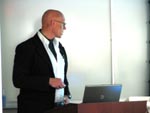Research Activities >
Programs >
Nonequilibrium Interface and Surface Dynamics 2007
|
|
Length Scales in Step-Bunch Self-Organization
during Annealing of Patterned Vicinal Si(111)
Surfaces
CSIC Building (#406),
Seminar Room 4122.
Directions: home.cscamm.umd.edu/directions
|
Length Scales in Step-Bunch Self-Organization during
Annealing of Patterned Vicinal Si(111) Surfaces
Professor
Raymond Phaneuf

University of Maryland
|
Abstract:
Using lithographic patterning and high-temperature
annealing we investigate the length-scale dependence
of self-organization of step-bunches on vicinal
Si(111) surfaces. Sublimation and diffusion result
in the motion and interference of misorientation-derived
straight steps and the circular steps which bound
cylindrical pits. Annealing of patterns with small
pit diameters produces a rapid relaxation to
straight step-bunches, while larger structures
maintain significant in-plane corrugations for as
long as the out-of-plane corrugations persist; these
two types of behavior are separated by an extended
transitional regime . We simulations of the
evolution using the mesoscopic model proposed by
Weeks, et al [1] to describe the motion of
individual steps under the effects of sublimation,
step stiffness (line tension), and step-step
interaction. The qualitative consistency between our
simulation and experiment [2] suggest that
thermodynamic driving force, such as the
step-stiffness and step-step interaction dominate
the evolution of the step structure during high
temperature annealing. We are also able to explain
the characteristic length scales separating the
three regimes of relaxation based upon simple
arguments based upon a competition between terms
which drive step velocity.
[1] J. D. Weeks, D.-J. Lui, and H.-C. Jeong, in
Dynamics of Crystal Surfaces and Interfaces, edited
by P. M. Duxbury and T.J. Pence (Plenum Press, New
York and London 1997), pp. 199-216
[2] T. Kwon, H-C. Kan, R. J. Phaneuf, Appl. Phys.
Lett. 88, 071914 (2006)
*Work supported by the Laboratory for Physical
Sciences and by the NSF-MRSEC at the University of
Maryland, DMR 0520471
[slides] |
|